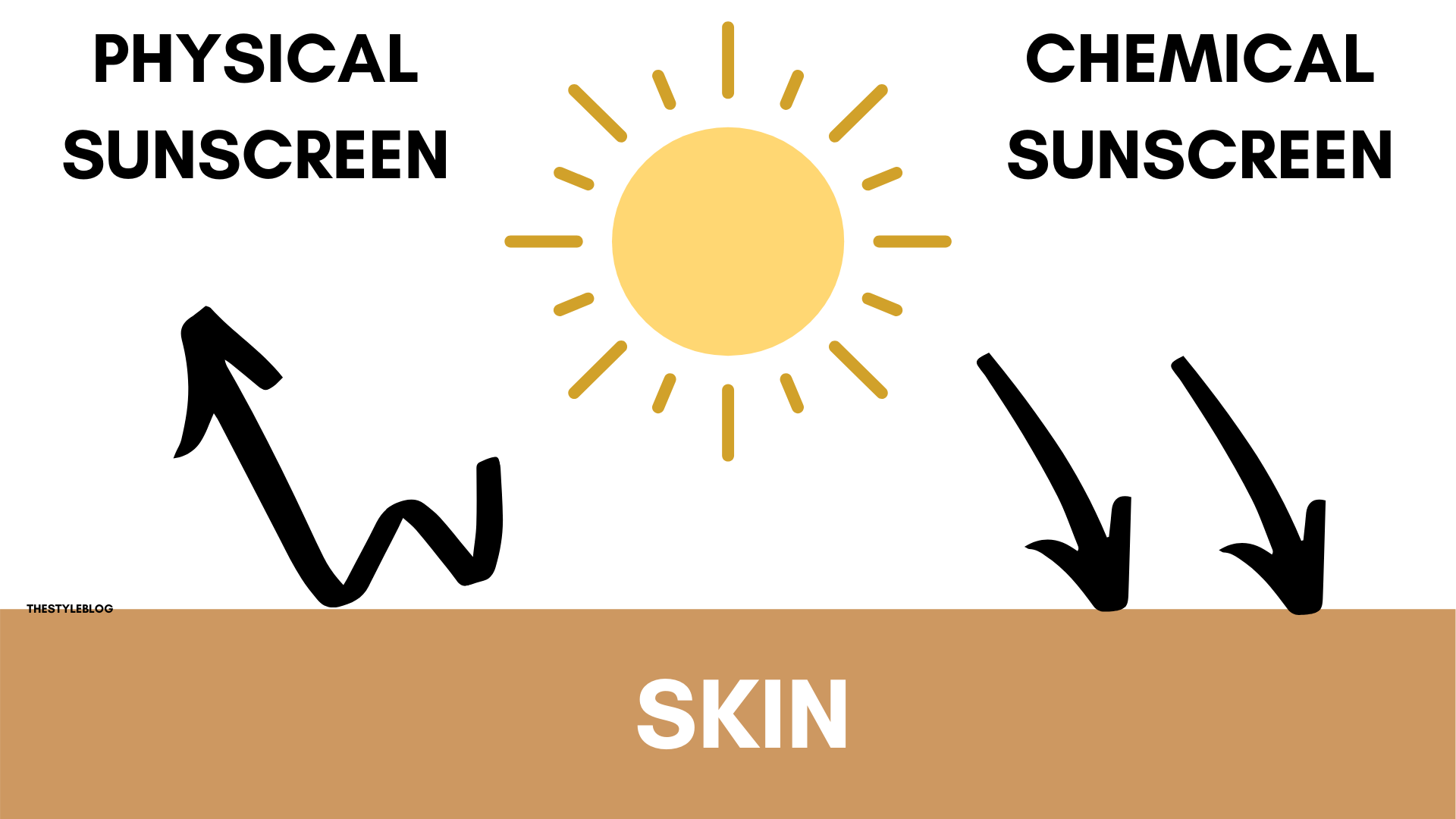Which sunscreen is better: chemical/organic or physical/mineral?
| Physical/Mineral Sunscreen | Chemical/Organic Sunscreen |
| Sits on top of the skin & reflects the sun’s rays instead of absorbing them | Absorbs UV rays & turns them into heat & then releases the heat |
| Can be less irritating because of the lack of chemicals (ideal for babies & those with sensitive skin) | Can be irritating & cause stinging, burning, & tingling |
| Can feel heavy on skin or leave a white, chalky cast which is especially difficult for darker skin tones | Typically absorbs quickly & turns transparent, thinner formula |
| Easier to come off with sweat and water | More sweatproof and waterproof, but still needs regular reapplication |
| No wait period needed between application and sun exposure | Need to wait 20 minutes between application & sun exposure to be effective |
| Can be better for acne-prone skin because it’s less likely to clog pores | Can clog pores & cause skin irritation, especially on face |

Physical sunscreen sits on top of the skin & reflects the suns rays while chemical sunscreen attracts the sun’s rays, absorbs them, & then releases them as heat.
Pregnancy & the Chemical Sunscreen Ingredient Oxybenzone
Some studies have shown that oxybenzone could potentially cause a birth defect (Hirschsprung’s disease) if used during pregnancy (in large amounts during the first trimester). It is very rare, & don’t panic if you’ve used it! I accidentally used it when I was pregnant, but just try to switch now that you know.
Sources:
Oxybenzone found in mothers’ urine could increase risk of Hirschsprung’s disease in neonate HERE
American Academy of Pediatrics recommends choosing a sunscreen for children that doesn’t contain oxybenzone HERE
Impacts of oxybenzone in blood stream HERE
Chemical Sunscreen Ingredients Found in Harmful Levels in the Bloodstream
An FDA study has shown that 7 chemical sunscreen ingredients have been found in high concentrations in the bloodstream, some after only one use. However, you should not panic! They’re not sure yet if this actually causes a problem, & it is understood right now that skin cancers are far more dangerous than a potential risk of sunscreen absorption so don’t let that keep you from wearing sunscreen. The FDA has urged for more testing & trials to determine if these concentrations are actually harmful. They may pose no risk, but further testing is needed. If you’re worried you can always switch to a different chemical sunscreen or a mineral sunscreen.
Sources:
Summary from WebMD that explains this very well HERE
FDA’s randomized clinical trial found avobenzone in large plasma concentrations in humans & also small plasma concentrations of oxybenzone, octocrylene, & ecamsule HERE
Coral Bleaching & Marine Life Damage
Certain countries have banned sunscreens containing oxybenzone & octinoxate because they lead to coral bleaching & can be dangerous to marine ecosystems. It’s important to note that these chemical sunscreen ingredients are not 100% to blame for coral bleaching. This is likely a combination of global warming, pollution, overfishing, & sunscreen chemicals. Many studies have shown that in a controlled environment, coral bleaching was caused from exposing the coral to oxybenzone. I try to make sure I wear a “reef-safe” sunscreen while at the beach.
Sources:
Oxybenzone combined with global warming aids in coral bleaching study HERE
National Ocean Service (NOAA) explains how sunscreen chemicals enter our oceans & effect our marine life such as green algae, coral, mussels, sea urchins, fish, & dolphins HERE
Study of oxybenzone’s effect on coral HERE
Bottom Line
Choose a sunscreen that you like & will remember to use. Nothing written here is more important than protecting your skin from skin cancer so if you currently love your chemical sunscreen, keep wearing it! If you enjoy your physical sunscreen, no need to switch. Get in a habit of applying your sunscreen first thing in the morning & reapplying throughout the day, especially if you’re going to be in the sun. Always look for broad spectrum coverage & SPF of at least 30. The most important thing you can do with this information is find a sunscreen you like & use it every single day.
Recommended video: 6 Ways to Protect Your Skin from Sun Damage
Products in video
• My favorite facial sunscreens: Elta MD, Clinique
• My favorite physical sunscreen for our whole family
• Dress I’m wearing (Tie Dye Blue, Small)
• Earrings (Gold/Ivory Mother of Pearl)
• Lipstick (Candy K)
• Eyeshadow palette
• Nail polish (Souq Up the Sun)
All of my room décor & filming setup linked HERE
This post is not sponsored, and nothing was sent to me for free or for review. This post contains affiliate links. When you purchase through an affiliate link, sometimes I receive a small percentage of the sale at no cost to you. Thanks for your support!

I think this website contains some really great info for everyone : D.
Everything is very open with a very clear explanation of the issues. It was definitely informative. Your site is useful. Many thanks for sharing. Debby Dunstan Joy
Way cool! Some extremely valid points! I appreciate you penning this post plus the rest of the site is also very good. Eden Bernardo Thacher
Excellent way of telling, and good piece of writing to get facts on the topic of my presentation topic, which i am going to deliver in college. Rubi Granny Nedi
Very nice post. I just stumbled upon your weblog and wanted to say that I have truly enjoyed browsing your blog posts.
Good day! Would you mind if I share your blog with my facebook group? There’s a lot of folks that I think would really enjoy your content. Please let me know. Thank you